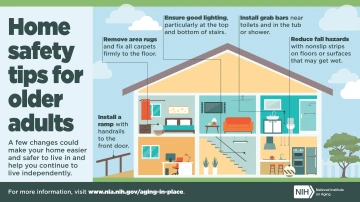
June is National Safety Month, and this year, the focus is on home safety for older adults and aging in place. While safety matters for people of all ages, the home environment takes on special significance as we grow older and wish to maintain our independence. This month brings essential reflections on how the home environment changes with aging.
I've noticed subtle shifts. My home's driveway has a decline that extends from the top of the street. I am in good physical shape. In my 30s and 40s, I would run up my driveway "hill" to collect the garbage and recycling bins. In my 50s, it was a jog. Now, in my early 60s, it is a power walk. Even with more options for healthy aging, challenges can prompt reevaluation of what matters most to us, particularly with changes to mobility, cognition, or any other aspect of our well-being that may impact our ability to maintain our home lives.
With one in four Americans aged 65 and older experiencing falls each year, and falls being the leading cause of both fatal and nonfatal injuries among older adults, home safety is crucial for maintaining independence and quality of life. This article highlights four essential approaches to creating safer homes for aging in place.
Fall-Proofing

Falls remain the most significant safety threat to older adults at home, with healthcare costs projected to exceed $101 billion by 2030. Many falls can be prevented through thoughtful home modifications. When fall-proofing a home, focus on the highest-risk areas: stairways, bathrooms, and the frequently traveled pathways between rooms. Consider how lighting, flooring surfaces, and furniture arrangement can increase or reduce fall risk. Remember that falling once doubles your risk of falling again, making prevention even more critical. Consider the daily activities that matter most (like my trek up the driveway with garbage cans) and consider adapting or modifying these activities, homes, and property to continue them safely as abilities change.
Addressing Cognitive Safety Needs
For older adults with Alzheimer's disease or other cognitive impairments, safety needs extend beyond physical hazards. The home environment must adapt as memory, judgment, and perception change. The key to cognitive safety is anticipating potential confusion or misunderstanding before it leads to danger. This might mean simplifying the environment, enhancing visual cues, securing potentially hazardous items, or installing monitoring systems that alert caregivers to potential problems. As cognitive abilities continue to change, safety needs evolve. Regular reassessment is crucial to address emerging risks and ensure that the home environment supports independence and safety.
Getting Professional Help
Professional assessments can identify risks and provide tailored recommendations addressing the older adult's needs and priorities. Professional evaluations go beyond generic checklists; they consider home layout, personal health considerations, and activities most important to quality of life. Whether bringing garbage cans up a sloped driveway or continuing to garden, cook, or pursue hobbies, professionals can help develop strategies that support goals for aging in place. Consider seeking professional assessment after any health change, when planning home renovations, or simply as a proactive step toward safer aging in place.
Financial concerns shouldn't prevent the necessary safety modifications, but often do. Explore available resources like state housing finance agencies, Medicare/Medicaid (with a doctor's order), veterans' benefits, and nonprofit organizations that can help offset costs. Local agencies on aging may offer these services or refer you to an organization that can assist you.
Creating a Backup Care and Emergency Plan
No matter how well we prepare, unexpected circumstances can arise that require additional support, such as an injury, illness, or temporary incapacity. Developing a comprehensive emergency and backup care plan is essential for both those who live independently and for family caregivers. Key elements of a backup care plan include:
- Identifying potential substitute caregivers among family, friends, or professionals
- Creating detailed documentation of care routines, medical needs, and preferences
- Considering alternative sources of care support
- Preparing for the financial aspects of emergency care needs
- Safety modifications focusing more on living fully in the places we cherish.
Creating a safer home isn't just about preventing accidents; it's about preserving the ability to do what matters, whether managing household chores, pursuing hobbies, maintaining independence, or simply living our lives how we want. Adaptive environments create spaces for joy, purpose, and dignity. Bringing garbage cans up a driveway may seem mundane, but maintaining these routines represents something more profound: control over daily life, connection to home, and continuity of self.
Resources:
- CDC's STEADI Program: Comprehensive fall prevention resources and checklists
- National Council on Aging: Offers the "Falls-Free Check Up" and home safety information.
- AARP Home Fit Guide: Detailed guide for making homes safe and comfortable
- Alzheimer's Association: Specialized guidance for cognitive impairment safety
- Family Caregiver Alliance: Offers online Services by state
- Area Agencies on Aging or Eldercare Locator (1-800-677-1116) to arrange free or low-cost home assessments in your area.
- Pima Council on Aging
- Local fire departments: Many offer free safety checks

